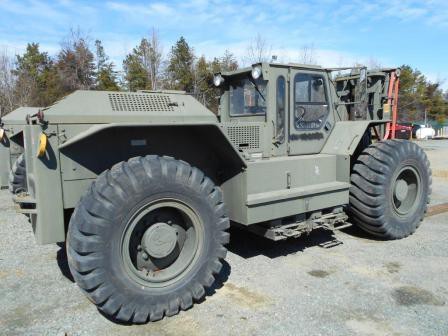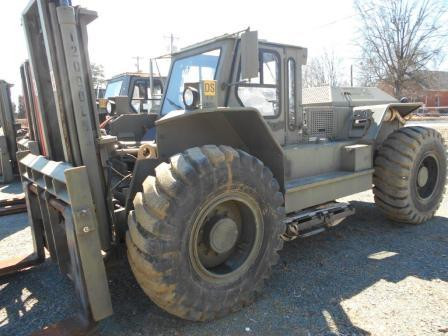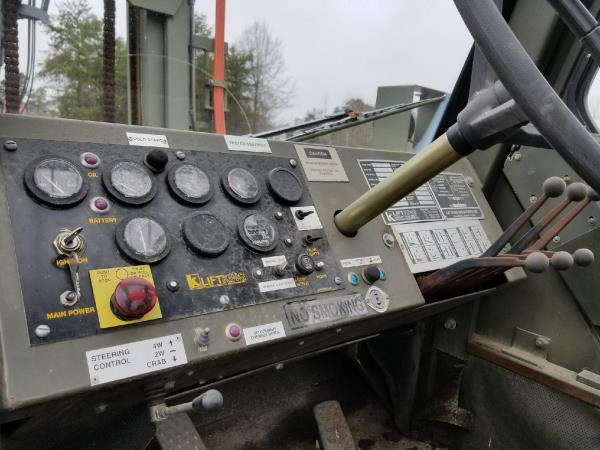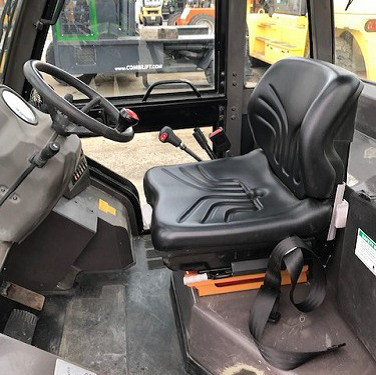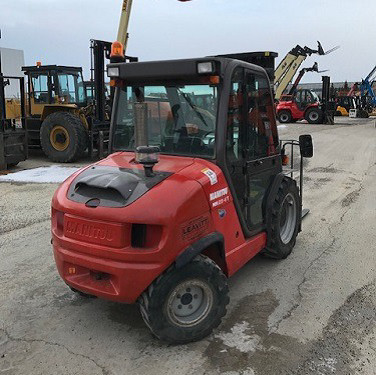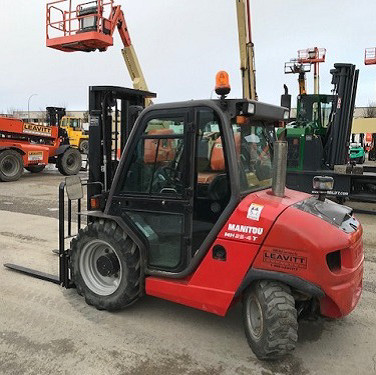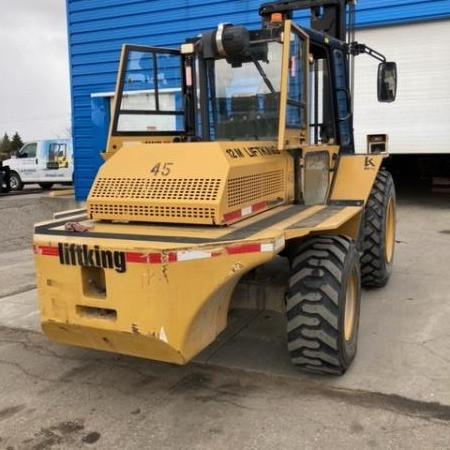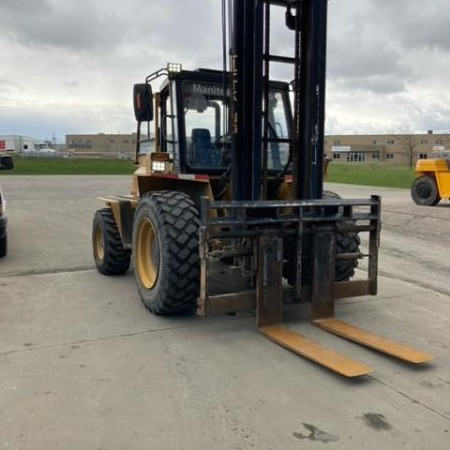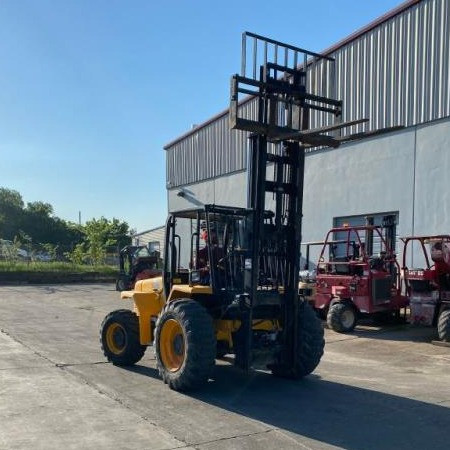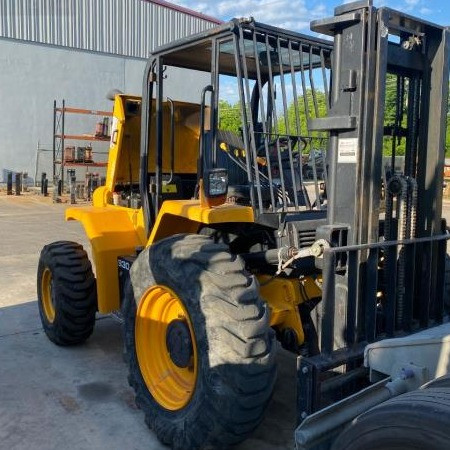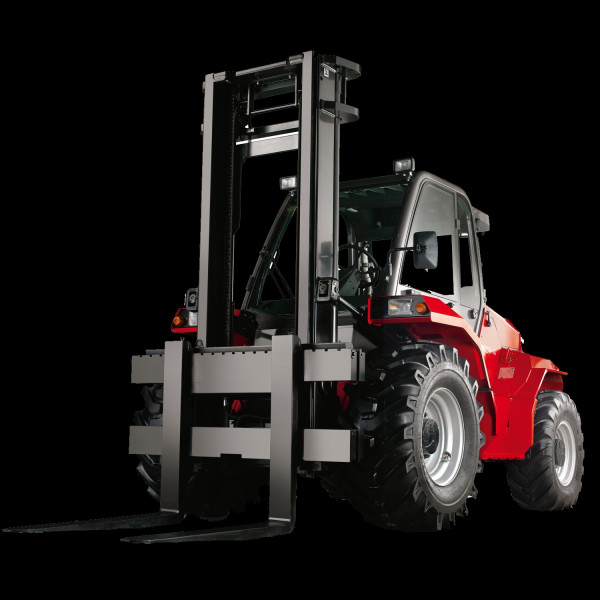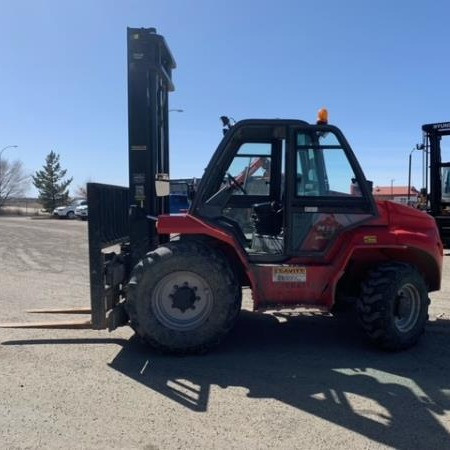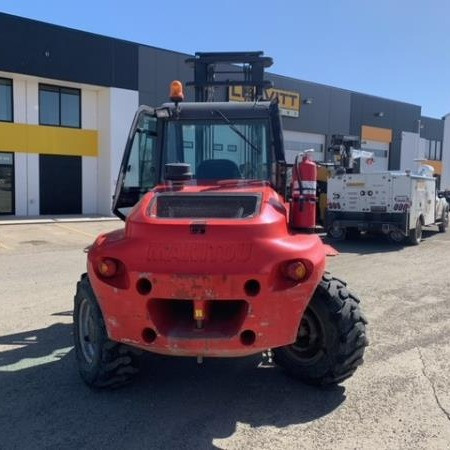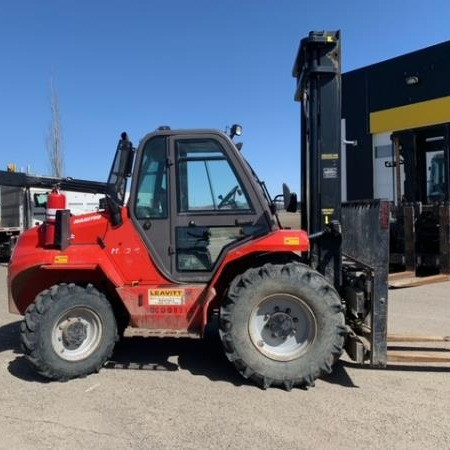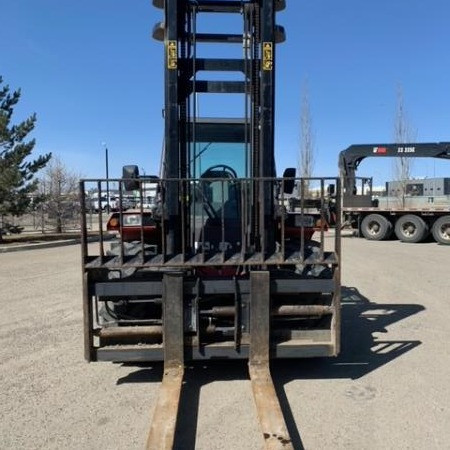Rough Terrain Forklift Ventura
Used Rough Terrain Forklift Ventura - Forklift trucks utilize two forks to transport pallets and load and unload cargo. The rough terrain forklift and the industrial forklift are the two main types of forklift trucks.
Industrial forklifts are mainly used in loading docks and warehouse applications with smooth and level surfaces. Rough terrain forklifts are better suited for rocky environments and uneven surfaces. Rough terrain forklifts are often seen at construction sites and outdoors. They have the weight capacity, size and tires to handle heavy loads. The main difference between industrial and rough terrain forklifts is that industrial forklifts are fitted with cushion tires, a common, over-the-road type tire. Rough terrain forklifts, on the other hand, are fitted with pneumatic tires, a type of tractor tire allowing for better traction and flotation properties. Industrial forklifts can be powered by internal combustion engines but are more frequently powered by an electrical source, such as battery or fuel cell whereas rough terrain forklifts are almost always powered by an internal combustion engine.
Types of Class 7 Rough Terrain Forklift Trucks
There are three main types of Class 7 Rough Terrain Forklift Trucks:
1. Straight mast forklifts;
2. Telehandler forklifts; and
3. Rotating telehandler forklifts.
Regardless of its type, all rough terrain forklift trucks are designed to handle, as their name suggests, natural rough terrain and disturbed rough terrain typical of construction and military sites. Rough terrain forklift units have better performance and maneuvering options. Safety considerations are taken into account for rough terrain locations with raising loads in difficult environments to keep the operator safe from tipping over. As with all forklift operation, the machine must be in a position to remain stable before lifting, transporting or lowering a load. Stability of ground and knowledge of proper lifting technique is essential for safe operation of rough terrain forklifts.
Straight Mast Forklifts
Designed to facilitate safe transport along difficult terrain such as demolition sites and construction locations, straight mast forklifts can complete the job safely and efficiently. These forklift trucks provide increased maneuverability and accessibility because it is fitted with big, heavy-duty pneumatic cushion tires. Uneven ground and rough surfaces are no match for pneumatic tires. It is common for straight mast forklifts to come with 2-wheel or 4-wheel drive. The majority of straight mast forklifts rely on propane or diesel fuel to equip them for interior short-term jobs. However, these machines are best suited for outside jobs. Both standard and straight mast forklifts offer similar lifting capacities weighing from 5000 to 36,000 pounds, depending on the model.
Telehandler or Telescopic Handler Forklifts
The distinct telescoping boom on telehandlers and telescopic handler forklifts contribute to the unit’s name. This specially designed boom allows the forklift truck to pick up loads and place them at differing heights in front of the unit. The reachability of the forklift provides the operator with greater flexibility when placing a load.
A standard telehandler forklift is long and low, with two wheels at the very front of the forklift and another pair of wheels toward the rear of the machine. The telescopic boom can be found at the back of the forklift, mounted on a pivot that is attached many feet higher than the frame of the unit. The left side of the machine houses the cab and the hydraulic fluid tank and the fuel tank are found opposite to the cab. The forklift engine and transmission are situated along the center of the machine. This popular design showcases a balanced forklift which is ideal for the machine’s stability with lifting, moving and lowering items.
Telehandler units offer significantly higher lifting heights compared to standard units. Otherwise known as high-reach telehandlers or compact telehandlers, these models perform. Compact telehandlers can extend their full load capacity from eight-teen feet and the high-reach models to fifty-six feet. Their load capacities usually range between 5,500 and 12,000 pounds.
All-wheel steering is popular for all-terrain forklifts and provides increased maneuverability. The power-shift transmission and steering features allow the operator to move the forklift into a safe and successful working proximity.
Recent telehandler units showcase top-of-the-line ergonomic design to generate increased comfort and operator satisfaction. These features include tilted steering options and roomier cabs to increase operator comfort. These ergonomic upgrades have been shown to lessen repetitive stress injuries and lessen operator fatigue.
Most telehandler forklifts rely on a single joystick. The joystick is responsible for the hydraulic system and the boom operations.
These machines can use non-marking tires to allow them to be suitable for maintenance in stadiums and on buildings or billboards and sign operations.
Rotating Telehandler or Roto Telescopic Handler Forklifts
Roto telescopic handler forklifts or rotating telehandlers have numerous items in common with the standard telehandler model. The rotating telehandler can lift excessive loads to extreme heights safely and efficiently. This unit’s added turntable and rotation flexibility increases the types of jobs it can complete. Not having to reposition the forklift saves time and money. The rotating models have access to 360 degrees, creating a much greater workspace with immediate access.
Because of this additional feature, rotating telehandlers often have a second joystick to allow operation of the rotation function apart from the lift function. As with the standard telehandler forklift, rotating telehandlers are available with added features including power assist steering, four-wheel drive and minimized slip differential on the rear axle to boost traction and for additional safety.
Of course, a machine that can rotate has extra safety considerations to understand. Because of this, rotating telehandler rough terrain forklifts come with stabilizers to increase the safety when rotating loads from one side of the forklift to the other. Certain rotating telehandlers operate without stabilizers; minimizing the time it takes to reposition the machine and move to other workplace locations.
The standard telehandler offers fixed cab components and rotator telehandlers are generally smaller in comparison. Understandably, rotator telehandler machines can handler smaller load capacities compared to their standard telehandler counterparts. Ranging between four thousand and ten thousand pounds, rotating telehandlers can reach lift heights from 15 to 80 feet.
Standard and rotator telehandlers can double as a crane when outfitted with specific winch accessories. This means that these forklifts can sometimes allow a project to forego the need for a crane at the jobsite, saving time, expense and workspace.
Advancements for Rough Terrain Forklifts
Numerous attachments can be found for rough terrain forklifts including articulating booms, rotating fork carriages, booms, winches and similar items. Forklift attachments are vital for diversifying the machine. They will continue to be developed for years to come.
However, the bulk of advancements are expected to be in the form of safety features, built-in to manufactured rough terrain forklifts. The latest safety upgrades include automatic load restriction and other features. These systems automatically weigh a load and then calculate the safe reach distance of that load, taking into consideration the angle and extension of the boom. If the safe reach distance is reached, an alarm will sound, warning the operator to make the proper adjustments to either the boom angle, the reach distance or load weight.
Rough Terrain Forklift PDF
Stock Number: 267846 GL
Make: Liftking
Model: LK12000
Year: 2003
| Stock Number |
267846 GL |
| Make |
Liftking |
| Model |
LK12000 |
| Year |
2003 |
| Category |
Rough Terrain Forklift |
Stock Number: DP-MAN008 GL
Make: MANITOU
Model: MH25-4T
Year: 2016
| Stock Number |
DP-MAN008 GL |
| Make |
MANITOU |
| Model |
MH25-4T |
| Year |
2016 |
| Category |
Rough Terrain Forklift |
Stock Number: 209058 GL
Make: LIFTKING
Model: LK12M42
Year: 2015
| Stock Number |
209058 GL |
| Make |
LIFTKING |
| Model |
LK12M42 |
| Year |
2015 |
| Category |
Rough Terrain Forklift |
Stock Number: LS15257 GL
Make: JCB
Model: 930
Year: 2013
| Stock Number |
LS15257 GL |
| Make |
JCB |
| Model |
930 |
| Year |
2013 |
| Category |
Rough Terrain Forklift |
Stock Number: 208325 GL
Make: MANITOU
Model: M50.4
Year: 2015
| Stock Number |
208325 GL |
| Make |
MANITOU |
| Model |
M50.4 |
| Year |
2015 |
| Category |
Rough Terrain Forklift |
Stock Number: EQC008213 GL
Make: MANITOU
Model: M50
Year: 2017
| Stock Number |
EQC008213 GL |
| Make |
MANITOU |
| Model |
M50 |
| Year |
2017 |
| Category |
Rough Terrain Forklift |




